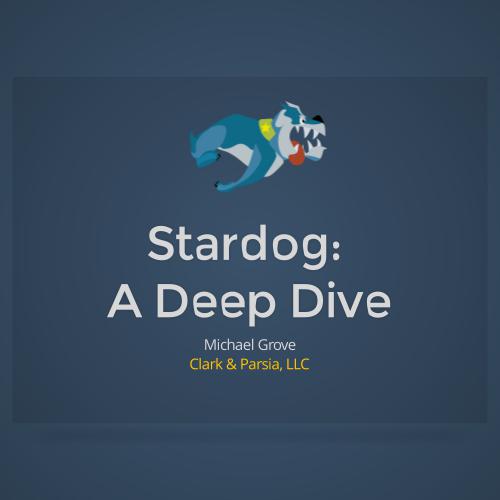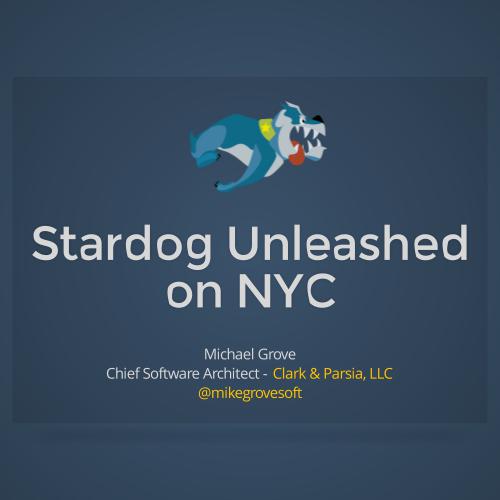Semantic Graphs are for Everybody
Michael Grove
Chief Software Architect - Clark & Parsia
About Us
- Founded in 2005
- Offices in Washington DC and Boston
- Customers in US gov't, banking, energy, health/bio, retail
- Strong academic partnerships in US, UK, Europe, and Mexico
- Leader in Semantic Technologies: graph databases, reasoning, planning, services
Semantic Graphs are for Everybody
- We agree that graphs are great
- Fantastic alternative to traditional systems
- Superior for many tasks
-
Semantics are a natural complement
- As asset for information integration & analysis problems
Semantic Graphs
- Organizations employ people other than programmers
- Not everything needs to be in code
- Especially business logic
- You can't just teach everyone programming either
- So why not semantics?
- Declarative, formal descriptions of nodes, edges and relationships
-
A little bit of semantics goes a long way
- Yields a powerful combination that is well suited for information integration tasks
Free Your Logic
- Adding semantics to our graphs gives meaning to our data
- Better yet, it lets us free our business logic from our codebase
- By encoding it in the graph
- Still better? It frees it from programmers (sorry!)
- Can be written in a high-level declarative language
- By programmers and non-programmers
- Also lets us talk about the same thing while using different vocabularies
So what can we do with semantic graphs?
Enterprise Semantics
- Complex organizations face challenging IT problems
- Enterprise Semantics: model-driven information integration for decision support & analysis
- Let an enterprise better utilize what they already have
- Data is an underutilized asset
- Leverage semantic graphs
-
Smart data, not strictly big data
-
Scale is not a necessary condition for utility
-
Problems are not always solved with more data
Smart Data
- Help deal with information overload
- Not just overload, but also management
- Semantics adds meaning to the data so the computer can help
-
Isn't this another silo?
- Consumers of the data simply issue queries
- But the data can live in place
- Key if it changes frequently
- Easier to bring new data online
- Domains use their own vocabulary, semantics provides the glue
- Facilitates cross-cutting views for information analysis & accessibility
How do we make this happen?
Put Business Logic in its Place
- Business logic is naturally a first class object to be curated, validated, versioned, etc.
- Encode your business logic in a language with a formal semantics
- Capturing expertise
- Inference rules & queries
- Let the computer do the work
- No programming required
- Can write programs, but that's not easier or more maintainable
- Actual experts in the business logic can implement it, not a programmer
- Lets non-programmers do complex information processing without having to write code
Reasoning
- Make implicit information explicit
- Consistency checking
- Find contradictions in your logic
- Entailment
- Answer queries using reasoning
-
Integrity Constraint Validation
- In some use cases, data consistency is crucial
- Explanations
- Logical debugging
- Can be as complex as your domain requires
- Expressivity broken down into profiles based on computational characteristics
Reasoning at work
- For example, enforcing security (ACLs)
- You want to see if Bob can access Resource1
- This can get hairy quick
- Finding this in a single query, or multiple related queries is not easy
Bob is-a Admin OR Bob created Resource1 OR (Bob hasRole ?x AND ?x canAccess Resource1) OR ... - It doesn't get better writing a program
-
We can leverage reasoning to make this easier
Queries get easier
- But if you encode your security policy in semantic graphs
Bob canAccess Resource1- That's it!
- Allows a more concise and maintainable query
- Shields you from evolution in the security policies in your application
- Try updating that query (or program) for each change!
Seat Belts Required
- Data is key for solving problems with Enterprise Semantics
- As I said, smart data
- In some use cases, data consistency is crucial
- So we need to be able to enforce integrity constraints over our data
- Age must be a positive integer
-
Supervisors may not supervise more than 10 employees
- All US Citizens must have one Social Security Number and it must be unique
- ...
Integrity Constraints
-
Custom logic to validate incoming data can be complex & time-consuming
- Not to mention telling a user what they did wrong
- No need to enforce some in the application layer, some in the database ...
- Semantic Graphs make this easier
- Again, no reason to write more code
- Can use same language as reasoning
- A rich modeling language for integrity constraints
- The high-level expressive syntax makes authoring complex validations easier
- Can be authored by the experts
-
Reasoning is used to satisfy, or violate, your constraints
Houston, we have a problem...
- Things go wrong, it's inevitable
- People fat-finger stuff when doing data entry
- Errors modeling the business logic
- You can sit around and debug them
- Debugging is fun, right?
- Some Programming Required
- Or you can have the computer tell you what is wrong
- In fact, it will tell you why
Explanations
-
Tells you why something is the case
- Inference from business logic you don't understand?
- Someone violate an integrity constraint?
- You get a proof
- Aids traceability & debugging
- Pinpoints the exact issue
- Can reference other proofs
- Even tells you how to fix it
- Or in some cases, fixes it for you
Oh, they're still graphs
- Semantic graphs are still graphs
- Adding semantic capabilities does not diminish their graph-ness
- You can pointer chase if you want
- But all the normal algorithms still apply
- Page Rank
- Clustering
- Vertex Degree Scoring
- Betweenness Centrality
- Shortest path
- and so on...
Did I mention the standards?
- All of this is based on W3C standards
- Data format, query language, semantics; none are proprietary
- Don't like your current vendor? Just switch
- Standard semantics means queries won't return different answers
- No ETL required to move your data
- Makes interoperability easier
- Promotes re-use
- Semantics does not change, data retains original meaning
Who uses this?
- VIACOM
- Best Buy
- SAIC
- NASA
- Wolters Kluwer
- JPMorgan Chase
- inQuest Technologies
- IBM
A Quick Example: POPS
- NASA is a big, interesting organization
- 100k+ employees across 12 centers throughout the US
- They have a universe of data
- And one simple problem, finding experts
- COTS solutions were not working
- All the information was already in-house, but collecting dust
- Enter POPS
- Created a model for their existing data
- Built a simple web interface to let them use their own data
- Saved NASA $38M a year!
Stardog
- The leading semantic graph database
- Design influenced by our approach to Enterprise Semantics
- Optimized support for reasoning, integrity constraints & explanations
- These resolve to query answering
- So our main focus was on a query planner
- Built to support information integration & analysis applications
- But general enough to support any semantic graph use case
- Also wanted best out of box experience possible
The Next Step
- Make it easier for all developers to contribute
- Organizations don't always have experts in semantics or graphs readily available
- Provide a tool that abstracts away these details
- Rely on web development standards
- HTML, Javascript, CSS, etc.
- Start building an application right away without focusing on learning the semantics or the graphs
- Because the value is in solving the problem
Conclusions
- Graph databases offer advantages over traditional systems for many uses
- Semantics complement those advantages
- More than just programmers work at organizations
- Not everything needs to be code
- Key components, such as business logic, can live separate
- And thus, be created & maintained by non-programmers
- So using semantic graphs we retain advantages of graph databases, while adding features valuable to the enterprise
- Promotes adoption & interoperability
- Facilitates smart data & Enterprise Semantics
Questions?
Thanks!
Semantic Graphs Are For Everyone
By Michael Grove
Semantic Graphs Are For Everyone
Semantic Graphs Are For Everybody explains how semantics added to graphs is a powerful combination of tools for information integration and analysis. We explain our approach to query answering, reasoning, integrity constraint validation, and graph analysis of RDF encoded semantic graphs. The talk focuses on how we provide these services to users by focusing on usability from start to finish. The goal of the talk is to show how adding semantics (that is, declarative logical descriptions) to graphs is makes semantic graphs useful for everyone.
- 1,935




